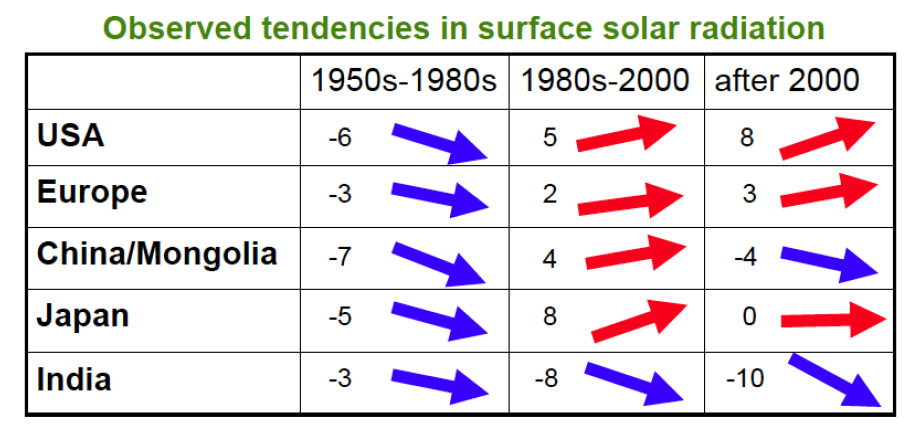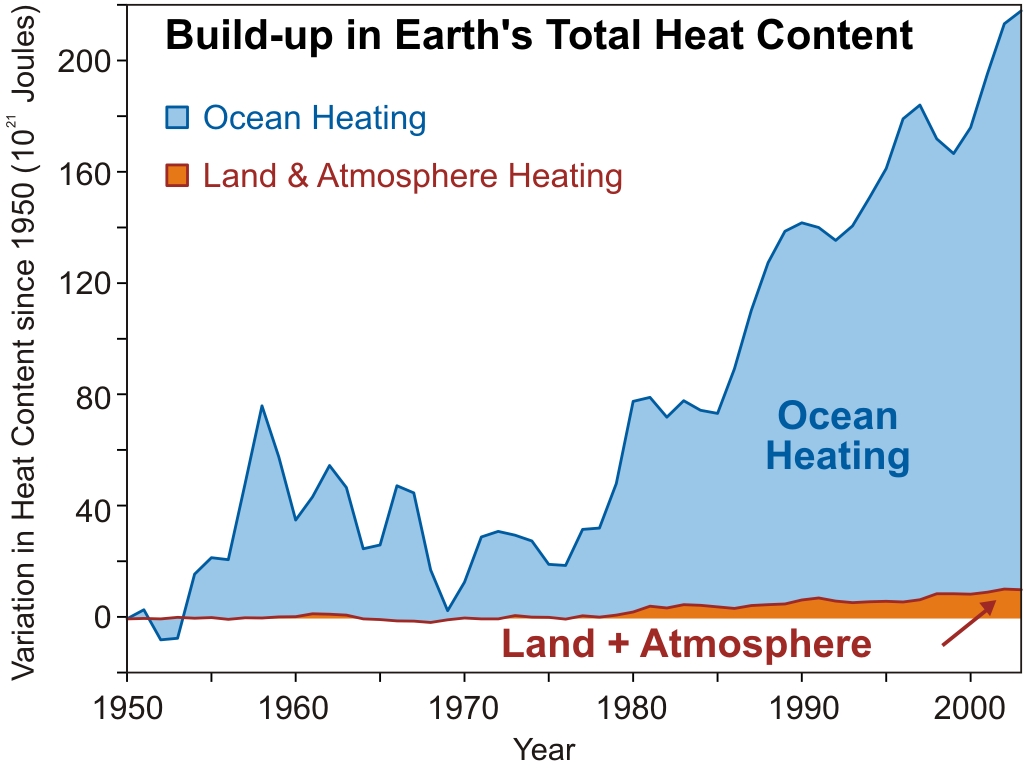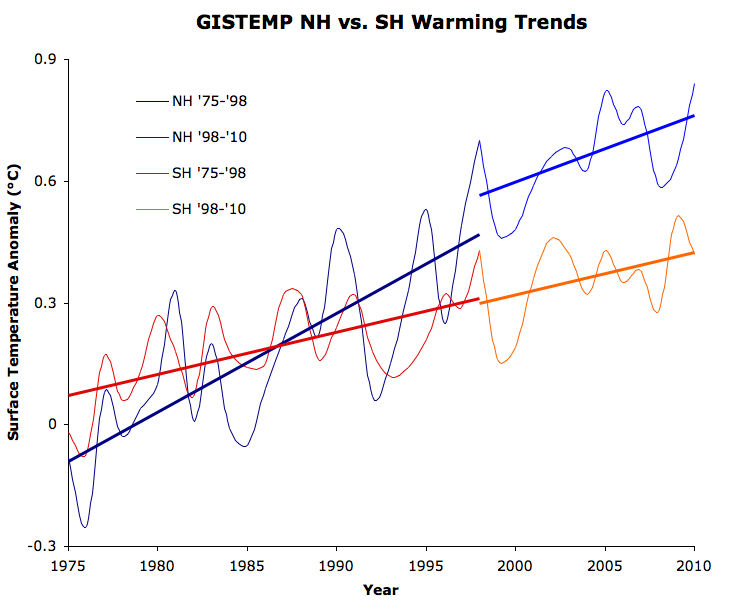Michaels Mischief #1: Continued Warming and Aerosols
Posted on 26 July 2011 by dana1981
Patrick Michaels is not known for his tendency to present a full accurate picture of climate science evidence (see for example his distortion of Hansen's famous 1988 study in testimony before US Congress). Nevertheless, Forbes business magazine has decided to give Michaels a blog on their website. We had hoped that when given the opportunity to write for such a high-profile media outlet, Michaels would strive for a more honest and complete representation of the scientific evidence for his newfound audience. Unfortunately, as we will see below, Michaels' Forbes blog appears to continue his problem with leaving out the inconvenient bits of data, in addition to the now familiar "skeptic" pattern of self-contradiction.
Michaels vs. Michaels
In a recent blog post, between his title and second sentence, Michaels managed to contradict himself twice:

As Michaels undoubtedly knows, 'no statistically significant [at a 95% confidence level] warming' is not even remotely equivalent to 'no warming'; this is a Fox News and Daily Mail-level lie. According to the University of East Anglia (UEA) data (HadCRUT), the average surface temperature has warmed 0.12°C since 1996 - it may not be statistically significant, but that's the trend Michaels references in his quote. So he effectively goes from saying 'no warming' to '0.12°C warming' back to 'no warming' in the span of two sentences!
Ironically, in making this argument, Michaels relies exclusively on the HadCRUT surface temperature data set compiled by the Met Office Hadley Centre and UEA Climatic Research Unit (CRU). But Michaels has previously severely criticized the CRU data set:

So why is Michaels now relying exclusively on a data set which he has previously criticized so harshly? Most likely it's because HadCRUT shows the smallest warming trend over the past 10 to 15 years, in which case Michaels is not only contradicting himself, but cherrypicking.
The Warming Continues
Michaels also engaged in some rather blatant cherrypicking by choosing November of 1996 as his starting point. "Skeptics" used to claim that there has been no [statistically significant] warming since 1995, but as we previously reported, the global warming trend since 1995 in the HadCRUT data set is now statistically significant at the 95% confidence level. So Michaels has moved the goalposts and selected the earliest date at which the HadCRUT trend fails this statistical significance test, and then deceived his audience by claiming that lacking stastistical significance means "no warming."
But HadCRUT isn't the only game in town, and as noted above, Michaels supposedly doesn't trust their data. The global warming trend in the NASA GISS data set, for example, is statistically significant over the cherrypicked period in question.
And of course surface temperatures are only a small part of the global picture. The vast majority of heat is going into the oceans:
Thus we see that Michaels' titular claim of no warming for 15 years is wrong on many, many levels. The error-riddled introduction to the post leads to a discussion of a paper we recently reviewed: Kaufmann (2011).
Kaufmann (2011)
As Rob Painting discussed in his analysis of the paper, Kaufmann et al. examined the slowed rate of global warming between 1998 and 2008 (note that we're no longer looking at November 1996 to June 2011, so Michaels' error-riddled introduction is also irrelevant to the rest of his post). Kaufmann et al. concluded that the slowed rate of warming could be explained by a combination of factors: changes in the El Niño Southern Oscillation (ENSO; 1998 was the strongest El Niño in a century, and 2008 was a strong La Niña year), declining solar activity (the end of this period saw the longest solar minimum in a century), and increased human aerosol emissions primarily from China's expansion of coal combustion as a power source.
Unfortunately, Michaels' description of the study's results isn't very accurate:
"Kaufmann’s team looked into how sulfate uncertainty impacted its results and decided that it was relatively minor."
Here are Kaufmann's actual results (emphasis added):
"Declining solar insolation as part of a normal eleven-year cycle, and a cyclical change from an El Nino to a La Nina dominate our measure of anthropogenic effects because rapid growth in short-lived sulfur emissions partially offsets rising greenhouse gas concentrations."
"The increase in sulfur emissions slows the increase in radiative forcing due to rising greenhouse gas concentrations (Fig. 1). Net anthropogenic forcing rises 0.13 W?m2 between 2002 and 2007, which is smaller than the 0.24 W?m2 rise between 1997 and 2002."
Even though human CO2 emissions accelerated between 2002 and 2007, the anthropogenic forcing increase actually slowed by 46% as compared to 1997 to 2002, due to the increase in aerosol emissions. This is hardly a "relatively minor" impact. In fact, Solomon (2011) concluded that aerosol cooling has offset one-third of the CO2 warming since 2000. Wild (2011) also found that the amount of solar radiation reaching the Earth's surface has declined significantly since 2000 over east Asia:

Changes in surface solar radiation observed in regions with good station coverage during three periods. The 1950s-1980s show predominant declines (“dimming”, left column), the 1980s-2000 indicate partial recoveries (“brightening”, middle column) at many locations, except India, while recent developments after 2000 show mixed tendencies (right column). Numbers denote typical literature estimates for the specified region and period in W/m2 per decade (Wild 2011).
More Aerosol Research
Michaels makes the valid point that the effects of aerosols on global temperatures remains a significant uncertainty in climate science. He claims that since aerosols have a short atmospheric lifetime, they aren't well-mixed throughout the atmosphere (unlike greenhouse gases). Thus if they have a significant cooling effect, it should be observed primarily in the northern hemisphere, where China is located.
However, China is located relatively close to the equator. As Rob Painting noted in his Kaufmann post, according to Rasch (2000), emissions from Asia are able to reach the upper atmosphere and spread out over both hemispheres. Hatzianastassiou (2011) actually found that solar dimming has been greater in the southern than northern hemisphere, because the aerosol cooling effect is largest in pristine areas where there is little pollution to begin with. This research directly contradicts Michaels' assumptions. Furthermore, there could be other effects (like ENSO) affecting the warming trends in the southern vs. northern hemisphere.
Nevertheless, Michaels proceeds with his faulty premise by plotting hemispheric data from HadCRUT (for which he appears to have discovered a newfound appreciation), and notes that since 1998, the northern hemisphere shows a slight warming trend while the southern shows a slight cooling trend. Michaels then declares that he has debunked Kaufmann's research, and proven that climate sensitivity is low.
The Rest of the Picture
It should go without saying that it's unwise to declare that virtually all previous climate sensitivity studies are wrong, based on little more than a superficial analysis of 10 to 12 years of surface temperature data. But the real flaw in Michaels' argument is that he only looks at the hemispheric temperature trends since 1998, but fails to compare them to the pre-1998 trends.
We know that over the past century, the southern hemisphere has warmed more slowly than the northern hemisphere (primarily because it contains less land and more oceans, and water takes a lot of time and energy to heat up). So the fact that the southern hemisphere is still warming less quickly than the northern hemisphere doesn't tell us anything by itself. We need more data to see the whole picture.
According to HadCRUT northern hemisphere data, the warming trends for 1975-1998 and 1998-Present were from 0.18°C/decade and 0.055°C/decade, respectively. In the southern hemisphere, the trends were 0.13°C/decade to -0.046°C/decade. So this data does support Michaels' premise: the southern hemisphere trend decreased more than the nothern hemisphere.
However, the data from NASA GISS shows a different picture. The figure below shows the surface temperature and linear warming trends according to GISTEMP from 1975 to 1998, and 1998 to 2010.
As you can see, the southern hemisphere warming trend is almost identical during the two periods (~0.1°C per decade), whereas the northern hemisphere warming trend has declined 32%, from 0.24°C per decade to 0.17°C per decade.
Thus we see that contrary to Michaels' argument, it's neither necessarily true that aersols cooling should have had a larger effect in the northern hemisphere, nor that the southern hemisphere warming necessarily slowed more than the northern since 1998. The effects of aerosols (both geographic and global) remain a significant uncertainty, and Michaels is grossly oversimplifying the situation, which leads him to the wrong conclusion.
Summary
Michaels committed the dishonest act of equating 'no statistically significant warming' with 'no warming'. He relied exclusively on CRU temperature data to make his arguments, even though he has previously criticized this same data, because the other temperature data sets do not support the arguments Michaels makes. On top of cherrypicking data sets, Michaels cherrypicks the exact earliest month to make the deceptive 'no statistically significant warming' argument.
Michaels' portrayal of Kaufmann's study was not very accurate, nor were his assumptions about the geographic distribution and effects of aerosols. Overall, other than noting that the effects of aerosols remain a significant uncertainty, there is little accurate scientific content in Michaels' blog post, and he draws the wrong conclusion by grossly oversimplifies the picture.
Unfortunately we can undoubtedly expect to see much more of the same inaccurate representation of climate science from Michaels and Forbes in future blog posts, which will likely be the subjects of future Michaels Mischiefs.































 Arguments
Arguments
































[DB] ETR has tried to pull this wool over SkS eyeballs several dozen times now, without success. It grows tiresome.
[DB] Inflammatory snipped.